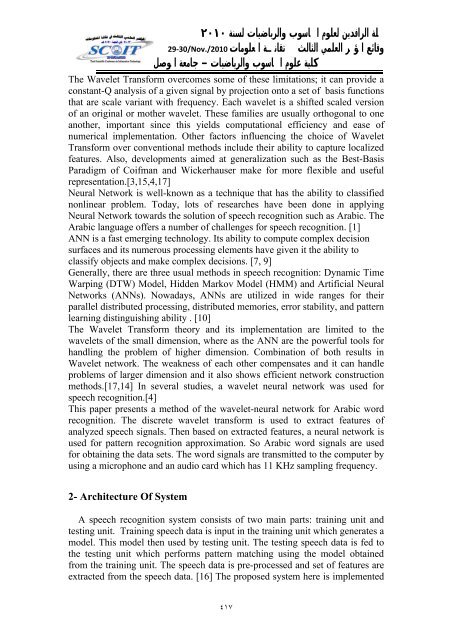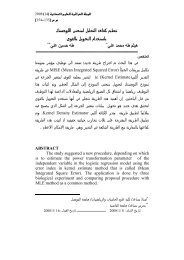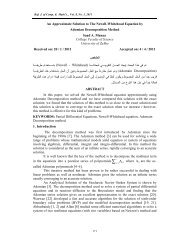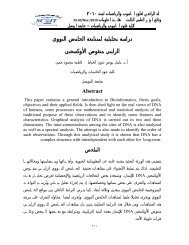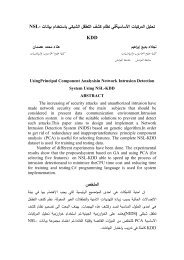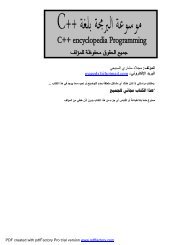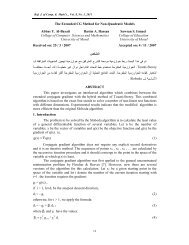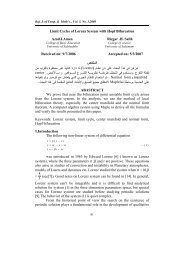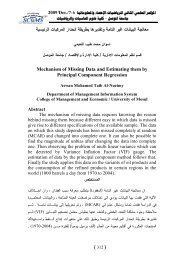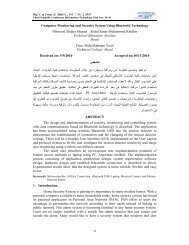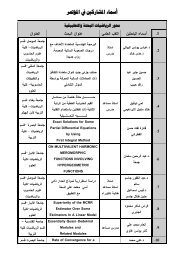arabic word recognition using wavelet neural network
arabic word recognition using wavelet neural network
arabic word recognition using wavelet neural network
Create successful ePaper yourself
Turn your PDF publications into a flip-book with our unique Google optimized e-Paper software.
مجلة الرافدين لعلوم الحاسوب والرياضيات لسنة ٢٠١٠<br />
وقائع المؤتمر العلمي الثالث في تقانة المعلومات<br />
كلية علوم الحاسوب والرياضيات – جامعة الموصل<br />
29‐30/Nov./2010<br />
The Wavelet Transform overcomes some of these limitations; it can provide a<br />
constant-Q analysis of a given signal by projection onto a set of basis functions<br />
that are scale variant with frequency. Each <strong>wavelet</strong> is a shifted scaled version<br />
of an original or mother <strong>wavelet</strong>. These families are usually orthogonal to one<br />
another, important since this yields computational efficiency and ease of<br />
numerical implementation. Other factors influencing the choice of Wavelet<br />
Transform over conventional methods include their ability to capture localized<br />
features. Also, developments aimed at generalization such as the Best-Basis<br />
Paradigm of Coifman and Wickerhauser make for more flexible and useful<br />
representation.[3,15,4,17]<br />
Neural Network is well-known as a technique that has the ability to classified<br />
nonlinear problem. Today, lots of researches have been done in applying<br />
Neural Network towards the solution of speech <strong>recognition</strong> such as Arabic. The<br />
Arabic language offers a number of challenges for speech <strong>recognition</strong>. [1]<br />
ANN is a fast emerging technology. Its ability to compute complex decision<br />
surfaces and its numerous processing elements have given it the ability to<br />
classify objects and make complex decisions. [7, 9]<br />
Generally, there are three usual methods in speech <strong>recognition</strong>: Dynamic Time<br />
Warping (DTW) Model, Hidden Markov Model (HMM) and Artificial Neural<br />
Networks (ANNs). Nowadays, ANNs are utilized in wide ranges for their<br />
parallel distributed processing, distributed memories, error stability, and pattern<br />
learning distinguishing ability . [10]<br />
The Wavelet Transform theory and its implementation are limited to the<br />
<strong>wavelet</strong>s of the small dimension, where as the ANN are the powerful tools for<br />
handling the problem of higher dimension. Combination of both results in<br />
Wavelet <strong>network</strong>. The weakness of each other compensates and it can handle<br />
problems of larger dimension and it also shows efficient <strong>network</strong> construction<br />
methods.[17,14] In several studies, a <strong>wavelet</strong> <strong>neural</strong> <strong>network</strong> was used for<br />
speech <strong>recognition</strong>.[4]<br />
This paper presents a method of the <strong>wavelet</strong>-<strong>neural</strong> <strong>network</strong> for Arabic <strong>word</strong><br />
<strong>recognition</strong>. The discrete <strong>wavelet</strong> transform is used to extract features of<br />
analyzed speech signals. Then based on extracted features, a <strong>neural</strong> <strong>network</strong> is<br />
used for pattern <strong>recognition</strong> approximation. So Arabic <strong>word</strong> signals are used<br />
for obtaining the data sets. The <strong>word</strong> signals are transmitted to the computer by<br />
<strong>using</strong> a microphone and an audio card which has 11 KHz sampling frequency.<br />
2- Architecture Of System<br />
A speech <strong>recognition</strong> system consists of two main parts: training unit and<br />
testing unit. Training speech data is input in the training unit which generates a<br />
model. This model then used by testing unit. The testing speech data is fed to<br />
the testing unit which performs pattern matching <strong>using</strong> the model obtained<br />
from the training unit. The speech data is pre-processed and set of features are<br />
extracted from the speech data. [16] The proposed system here is implemented<br />
٤١٧


